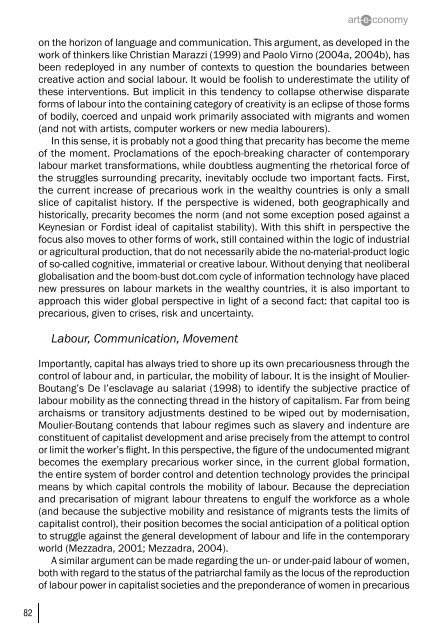art-e-conomy _ reader - marko stamenkovic
art-e-conomy _ reader - marko stamenkovic
art-e-conomy _ reader - marko stamenkovic
Create successful ePaper yourself
Turn your PDF publications into a flip-book with our unique Google optimized e-Paper software.
82<br />
on the horizon of language and communication. This argument, as developed in the<br />
work of thinkers like Christian Marazzi (1999) and Paolo Virno (2004a, 2004b), has<br />
been redeployed in any number of contexts to question the boundaries between<br />
creative action and social labour. It would be foolish to underestimate the utility of<br />
these interventions. But implicit in this tendency to collapse otherwise disparate<br />
forms of labour into the containing category of creativity is an eclipse of those forms<br />
of bodily, coerced and unpaid work primarily associated with migrants and women<br />
(and not with <strong>art</strong>ists, computer workers or new media labourers).<br />
In this sense, it is probably not a good thing that precarity has become the meme<br />
of the moment. Proclamations of the epoch-breaking character of contemporary<br />
labour market transformations, while doubtless augmenting the rhetorical force of<br />
the struggles surrounding precarity, inevitably occlude two important facts. First,<br />
the current increase of precarious work in the wealthy countries is only a small<br />
slice of capitalist history. If the perspective is widened, both geographically and<br />
historically, precarity becomes the norm (and not some exception posed against a<br />
Keynesian or Fordist ideal of capitalist stability). With this shift in perspective the<br />
focus also moves to other forms of work, still contained within the logic of industrial<br />
or agricultural production, that do not necessarily abide the no-material-product logic<br />
of so-called cognitive, immaterial or creative labour. Without denying that neoliberal<br />
globalisation and the boom-bust dot.com cycle of information technology have placed<br />
new pressures on labour markets in the wealthy countries, it is also important to<br />
approach this wider global perspective in light of a second fact: that capital too is<br />
precarious, given to crises, risk and uncertainty.<br />
Labour, Communication, Movement<br />
Importantly, capital has always tried to shore up its own precariousness through the<br />
control of labour and, in p<strong>art</strong>icular, the mobility of labour. It is the insight of Moulier-<br />
Boutang’s De l’esclavage au salariat (1998) to identify the subjective practice of<br />
labour mobility as the connecting thread in the history of capitalism. Far from being<br />
archaisms or transitory adjustments destined to be wiped out by modernisation,<br />
Moulier-Boutang contends that labour regimes such as slavery and indenture are<br />
constituent of capitalist development and arise precisely from the attempt to control<br />
or limit the worker’s flight. In this perspective, the figure of the undocumented migrant<br />
becomes the exemplary precarious worker since, in the current global formation,<br />
the entire system of border control and detention technology provides the principal<br />
means by which capital controls the mobility of labour. Because the depreciation<br />
and precarisation of migrant labour threatens to engulf the workforce as a whole<br />
(and because the subjective mobility and resistance of migrants tests the limits of<br />
capitalist control), their position becomes the social anticipation of a political option<br />
to struggle against the general development of labour and life in the contemporary<br />
world (Mezzadra, 2001; Mezzadra, 2004).<br />
A similar argument can be made regarding the un- or under-paid labour of women,<br />
both with regard to the status of the patriarchal family as the locus of the reproduction<br />
of labour power in capitalist societies and the preponderance of women in precarious


